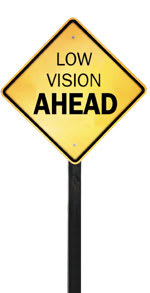|
LOW
VISION Putting patients behind the wheel...help or hazard? By William Croft Jr.
We've all read the accounts in the newspapers. Like the story about the legally blind mother who was arrested for driving her children to school in a golf cart. There is, to say the least, a great deal of controversy surrounding the subject of low vision patients driving a car. Whether they should or should not, the reality remains that driving by individuals with vision correctable only to 20/200 is still allowed in several states (see sidebar). And Washington State actually permits driving with worse vision than that. Nearly as bad is the fact that only 33 states include visual field testing in their driving exams. Though most states offer only restricted licenses to those with such vision impairment, it's still an issue that concerns both family and medical caregivers.
This was, in fact, a topic of discussion among several optometrists at the recent SECO meeting in Atlanta. In response to their queries, we are publishing this column that addresses both the product side--mostly spectacle-mounted bioptic telescopes--and the state regulatory side of driving by the partially sighted. At this point, close to 20 states allow bioptic and sometimes other telescopic lenses for driving. In discussing the use of telescopic devices for such purposes, Alex Yoho of Hawkins Optical in Topeka, Kan., says. "For driving, a superior bioptic position is generally in order. In this position, the scope is positioned high in the frame and angled upward two degrees for every millimeter above pupil center at primary gaze. With this configuration, the patient can negotiate his or her surroundings with gross vision and has only to tip the head down slightly to align the scope with his or her visual axis for more detail." In states that allow driving with a bioptic telescope, Yoho underscores the importance of having the patient try the device out even before receiving thorough training. Some doctors, adds Yoho, ask the patient to sign a waiver before dispensing the devise for driving purposes. As for in-vehicle training, he explains, "I usually recommend that they ride as a passenger and practice, pretending to drive looking under the scope, then spotting quickly. It is imperative that they understand that, since it severly alters depth perception, the device is not to be used for constant viewing while driving." INFORMATION SOURCES Doctors say professional retraining is imperative. Refresher courses are available from several groups:
Driver rehabilitation is such a big issue that there are several clinics around the United States that provide both driver evaluation and training. Several associations, like the American Academy of Ophthalmology (AAO), have released guidelines for driving competency.
YOUR DUTY So, what should the doctor's responsiblity be to the patient and the public? According to the AAO, he should help those patients whose acuity limits make it safe for driving under specified conditions and, on the other hand, do what he can to prohibit those who don't qualify from driving. And that final determination--as well as the necessary testing and appropriate training--should definitely be directed by a low vision rehabilitation specialist. Regardless of your own area of specialty, however, it is important to be familiar with what restrictions are used in your state. If you don't know the restrictions or laws in your area, contact your local Department of Transportation. What several of the experts we have spoken with recommend in terms of optimal legislation is a series of graduated licenses that clearly delineate restrictions and limitations. Though more than seven out of 10 states do require 20/40 vision for an unrestricted license, some still allow drivers with vision as low as 20/70 full driving privileges. What are those states? Six states--Arkansas, Indiana, Michigan, Nebraska, New Jersey, and North Carolina--issue non-restrictive licenses to persons with a visual acuity of 20/50. Four states--Georgia, Kentucky, Oklahoma, and Tennessee--allow 20/60 vision to drive unrestricted, and four states--Alabama, Florida, New York, and South Carolina--consider 20/70 vision to be acceptable for full driving privileges. Why is it important to know the regulations in your state? One reason is that physicians are increasingly being held liable for not warning patients of their limitations. Sources for this column include the U.S. Department of Transportation, the National Safety Council, The American Society of Ophthalmic Registered Nurses, and The American Academy of Ophthalmology. EB
|
Article
Putting patients behind the wheel...help or hazard?
Eyecare Business
April 1, 2000




